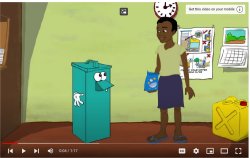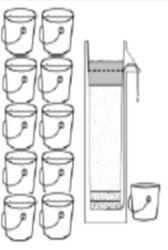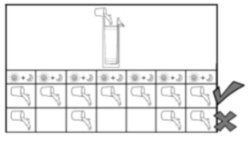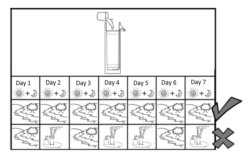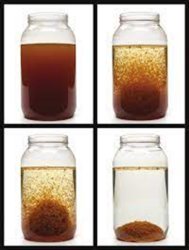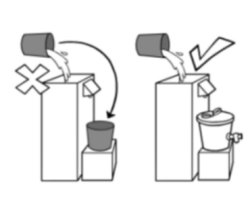
|
 Contact UsDrop of Hope BioSand Filters
Grow and Go curriculumDrop of Hope School ProjectEnglish Child EvangelismKids Discipleship TrainingCountries SelectedMore UCT Curriculum |
home>>grow and go>>water series>> drop of hope>> filter maintenance>> flush Drop of Hope - Maintenance Flush the Filter Embedded Microsoft Office presentation, powered by Office.
Educating the user how to Flush the Filter Tools and Materials
Flushing the filter will remove any dirt and fine sediment that may still be in the sand and gravel. Sometimes there is fine sediment that comes out the outlet tube as a result of the installation procedure. If these fine particles are not flushed out of the filter now, the user may see them in the water when they start pouring water through the filter, and they may stop using the filter. 1. Make sure the diffuser is in the filter. Put a bucket under the outlet to catch water. Pour a bucket of clear water into the top of the filter. Use the clearest water possible. 2. Look at the water coming out of the outlet tube. It may be dirty at first. It will get clearer as more water flows through the filter. Using the updated installation procedure above will reduce the amount of flushing needed. 3. When the filter stops flowing, throw the dirty water in the collection bucket away-pour it down a drain or into the bushes. Pour another bucket of water into the top of the filter. 4. Continue pouring water into the filter until the water coming out of the spout is clear. In some cases, it may take up to 40 to 80 litres (10 to 20 gallons) before the filtered water is clear. 5. Check the standing water level. The water above the sand should be 4 to 6 cm (1.5" to 2.5") deep. The surface of the water should be below the diffuser, not touching it. |
WHAT IF THE WATER NEVER GETS CLEAR?
Educating the user It is very important that users know how to use their filter. When a filter is first being installed, someone must teach them how to use it, and how and when to clean it. There is a lot of information for users to remember. Repeat visits will be necessary to follow-up with the users in order to answer their questions, remind them of information they have forgotten, teach new information, and demonstrate or affirm how they should use and clean the filter. 1. Use the BioSand Filter every day.
DO NOT go more than 2 days without pouring water into the filter. If you go away for more than 2 days, ask someone else to pour water into your filter every day. The filter needs a fresh dose of oxygen and nutrients. If you go too long without adding water, the standing water may evaporate, causing the biolayer to dry out and die. 2. Always pour water from the same source into the filter.
3. Use the cleanest, clearest water possible in the filter.
5. Disinfect your water - After removing the dirt and large particles, disinfecting the water will get rid of any of the pathogens that are left - even the very small ones that were too small to be filtered out of the water. You can use chlorine, boiling, or solar disinfection (SODIS). The BioSand Filter removes most of the dirt and pathogens. But for the best, safest water, you should also disinfect it. Disinfecting the filtered water is especially important: During these times, the biolayer is not working at its peak level. As such, the filter may not be treating water to its best capacity. Disinfecting the water at these times will make sure all pathogens are removed. 6. NEVER put Chlorine into the top of the filter Chlorine will kill the biolayer. Without the biolayer, the filter will not work as well. 7. ALWAYS make sure the diffuser is in the filter when you pour water in. Never pour water directly onto the sand. This may damage the biolayer. 8. ALWAYS keep the lid on the filter. This will keep insects, contaminants and other objects out. It will also keep hands and food from being contaminated by the dirty water and the diffuser in the top of the filter. 9. Keep the outlet tube open. DO NOT put a hose or tap on the filter outlet tube. Due to the siphoning effect in the outlet tube, putting a hose on the filter will drain the filter of all its water and may kill the biolayer. Putting a tap on the outlet tube will cause the standing water level to remain too high, which may kill the biolayer. 10. Use the filter only for water. Do not store food in the top of the filter. Some people store food inside the filter because it is cool. But the inside of the filter is not clean! It collected dirt and pathogens. It will make food dirty and unsafe to eat. Food may also attract animals and insects to the filter. Besides filling the filter with water, how else is the filter maintained? How do you clean it? The BioSand Filter requires very little cleaning. After the concrete body has cured completely, it should be cleaned out well with water and soap to remove any leftover grit or dirt. After that it can be safely filled with sand, gravel, and water in the user's home. Regularly wiping down the outside, lid, and diffuser plate is recommended. The filter is quite simple to use and comparable to taking care of a houseplant. The most important part of maintenance is making sure the biolayer remains healthy by feeding it one to four times a day with contaminated water. Once fed, the biolayer needs to digest and recover, so there should be at least one hour in between each use. Much like a houseplant, the biolayer cannot survive if there is too much or too little water. When not in use, a 5 cm layer of water covers the top of the sand. This layer must be maintained or the living microorganisms may die. If pouring turbid or visibly dirty water into the filter, the sand will collect dirt and slow down the flow of water. To fix this, a noninvasive method that does not disrupt the biolayer called, "Swirl and Dump," is used to clean the top of the sand and improve the flow. HANDOUT: Download Handout #14 - Educating the user to Flush the Filter English Educational Handout (To be translated into Shona) Learn how to Shona Clean the filter Learn how to Clean the filter |
| Copyright © 2024 www.UnitedCaribbean.com. All rights reserved. Disclaimer Click to Contact us |

